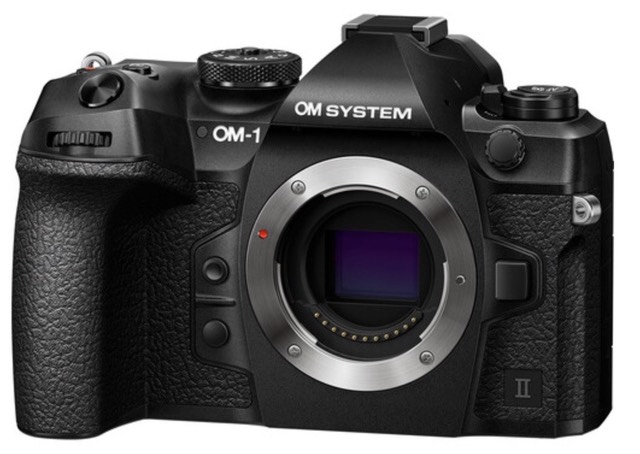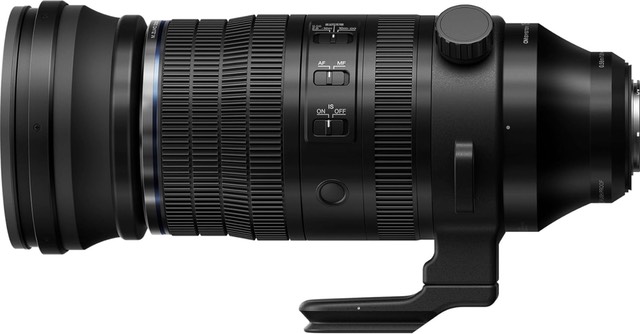Next up in the CIPA release queue is the OM-1 II.

Up front (literally) we have a name change. The original OM-1 had an Olympus name plate on the viewfinder front, while the new model gets an OM System replacement.
In terms of what really makes this new model a new model, the list is short, but potentially significant:
- The internal memory buffer has doubled.
- An updated IS system improves the CIPA rating to 8.5 stops.
- The camera is blackout free at slower frame rates.
- The camera can now record in 14-bit raw in the high-resolution (sensor shift) mode.
- A virtual graduated ND filter is available (computational, not mechanical), and regular ND can now be up to ND128.
- The focusing system gains a full human recognition to its autofocus AI, and the focus system overall has been consolidated and improved.
Overall, the changes to the camera are welcome, but after two years with the original camera feel more like a firmware update than any real change (other than the extra memory). A significant update, to be sure, but still, some things I believe still need addressing aren't changed in this new camera.

Along with the OM-1 II, OMDS also introduced two lenses, the 9-18mm f/4-5.6 II and the 150-600mm f/5-6.3. Both appear to be rebadging jobs. The wide angle zoom takes away the Olympus markings and replaces them with OM System ones as well as a newer external design ethos, but the optics appear to be the same as the original Olympus lens. The latter zoom is a bit of a controversial one in that the lens appears to be the Sigma full frame telephoto version in an m4/3 mount. The thicker OM filter layer on the top of the image sensor requires a slight tweak to how the focus is projected rearward, but otherwise this seems to be a Sigma optic being rebadged.
Commentary: When OM Digital Solutions took over the Olympus camera group I mentioned several issues with their naming decisions, and now you can see the result of that. If you accidentally type in omsystems.com in a Web browser instead of omsystem.com, well, you don't get the company making the camera. Heck, if you type in omdigitalsolutions.com, you get a Go Daddy "get this domain" page; you need to actually type om-digitalsolutions.com. This is a bit of marketing 101 failure.
The existing customers aren't going to have any real issues with this, as they've already re-pointed their Web browsers at the new pages, but for someone seeing or hearing the name for the first time, slight misses on what they type into a search engine aren't going to bring up the relevant pages. This is one of those things I call a "friction." In business, you want as few frictions as possible, as each tends to rob you of sales, and if you pile up enough of them, that could be enough to start a downward glide in your results.
Meanwhile, rebadging a Sigma optic means I need to come up with a new name. When Nikon did the same thing with some Tamron lenses back in the F-mount days, I began calling them Tamrikon. I guess now we have Sigmoms. (When I come up with these names, I first do a search to make sure that they're unique. Then it's fun to follow what happens next. You'll see that Tamrikon on Duck Duck Go brings up zsystemuser.com references first, then Internet fora posts, for instance. In other words, I can follow my word usage from my site to Web fora. A fun game for all. Well, okay, for me.)
Here's the problem with the Sigmoms just introduced: it's the same size and weight as the full frame version. In essence, OM Digital Solutions is saying this: we'll give you a 4:3 aspect 2x crop that's 20mp. Okay, but you'd get 26mp out of a Sony A7R Mark V with the same lens ;~). The question then becomes is the OM-1 body smaller and lighter than the A7R Mark V? Well, there's a 2 ounce (66g) advantage to the OM-1, but with that lens on the camera you're also at a minimum of 300mm effective. In other words, you get 300-1200mm at 20mp versus 150-900mm at 61 to 26mp. Oops. I'd rather have the Sony. I first warned about this problem back in 2003 with the introduction of the E-1: if the size/weight and capabilities are near identical, you don't want to be bringing the smaller sensor to the fight.
